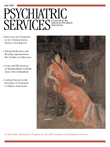Restraint and Seclusion: The Model for Eliminating Use in Health Care
The reduction and even the elimination of restraint and seclusion did not begin in 1999 with Guiding Principles on Restraint and Seclusion for Behavioral Health Systems ( 1 ), in 2003 with the American Psychiatric Association's material on the subject ( 2 ), in the Substance Abuse and Mental Health Services Administration's publication of the National Action Plan on Seclusion and Restraint ( 3 ), nor in 2001 with Centers for Medicare and Medicaid Services' interim final rule ( 4 ). Rather, efforts aimed at the reduction, and preferably the elimination, of mechanical restraint is an idea well rooted in the 19th century, and in fact, zero restraint was reported by some 19th century asylums ( 5 ).
In discussing the subject of restraint and seclusion it is important to note that when the term "restraint and seclusion" is used, one is actually referring to using either restraint or using seclusion. There should be no doubt that the combined use of restraint and seclusion is not permitted.
Murphy and Bennington-Davis take on the task of creating a manual with a contemporary approach to eliminating the use of restraint and the use of seclusion. Their venue is a 280-bed general hospital in Oregon with a freestanding psychiatric inpatient unit three blocks from the main hospital. That unit is secure with 24 beds and an average eight-day length of stay. Approximately one-third of persons admitted are having their first psychiatric hospitalization. To what degree one can generalize the authors' approach to psychiatric inpatient settings that are quite different from Salem Hospital is at this point an unanswered question.
The authors draw upon the ideas of Sandra Bloom and her approach of "trauma informed care," Xavier Amador and his thoughts as articulated I'm Not Sick, I Don't Need Help ; Prochaska and DiClemente's stages of change, Japanese industries' unacknowledged models for organizational change, the recovery model, the Hawthorne effect, and the Joint Commission on Accreditation of Healthcare Organizations. The authors do a fine job of weaving these quite discrepant sources into an interesting approach that they refer to as the "Engagement Model."
There is much that no one would dispute in this book. The authors contend that in order for treatment to be effective it must be "delivered safely, respectfully, and humanely." The authors explain that a hospital "is a social system that strongly influences employees and physicians through its culture," and that trauma-informed treatment plans incorporate a scheme for safety while the patient is in the treatment environment. They also state that a treatment plan should be unique and individualized and should contain hope and assume recovery. They say that all should work to create an environment "where the healed and the healers work together to find paths to recovery" and that the environment created should be "a place of absolute safety and respect for the staff and for the people served."
Where one might dispute the authors' approach is the emphasis they place on trauma theory. As Sandra Bloom opines in the foreword, "We talk a great deal about the issue of trauma because it is a profound problem that lurks behind most psychiatric and social dysfunction that results in hospitalization." And if that is the case, should we focus only on the trauma inflicted upon staff and patients when restraint or seclusion is used? Some would argue that we also need to focus on the trauma inflicted upon staff when they are in an environment that reprimands them or perhaps punishes them if they use restraint or seclusion or when they are asked to work in an environment in which they fear for their own safety because of the acuity of the ward or the dangerousness of the patients to whom they deliver care and treatment. An argument could also be made that patient-to-patient assaults are frequent and can be seen as a cost of refraining from using "too much" restraint or seclusion.
Restraint and Seclusion is a wonderful starting point for a discussion on any unit in any type of facility for creating an environment of more humane care. The writing is clear, concise, thoughtful, and compassionate. The same can be said of the message.
The risks, however, are that those who work in these environments will feel somehow that their efforts were ill informed or less than they ought to have been. They may never achieve what Murphy and Bennington-Davis seem to be suggesting are not only goals but perhaps standards. In those environments, as in any others, examination of the use of restraint and seclusion needs to be done while simultaneously looking at other variables, such as patient-on-patient assaults, patient-on-staff assaults, the use of polypharmacy, and the use of PRN psychotropic medication, as well as what population is served, for what length of time, with what resources, and under what legal sanctions. It may well be that the population in Oregon State Hospital and the population in Salem Hospital are two inpatient cohorts that are hospitalized in the same city but come from very different places.
1. Guiding Principles on Restraint and Seclusion for Behavioral Health Systems. Washington, DC, National Association of Psychiatric Health Systems, Feb 1999. Available at www.naphs.orgGoogle Scholar
2. Learning From Each Other: Success Stories and Ideas for Reducing Restraint/Seclusion in Behavioral Health. Arlington, Va, American Psychiatric Association, 2003. Available at www.psych.org/psych_pract/treatg/pg/learningfromeachother.pdfGoogle Scholar
3. National Action Plan on Seclusion and Restraint. Rockville, Md, Substance Abuse and Mental Health Services Administration, 2003. Available at http://alt.samhsa.gov/seclusion/sr_handout.htmGoogle Scholar
4. Thompson PR: Letter to the State Medicaid Directors. Centers for Medicare and Medicaid Services July, 2001. Available at www.cms.hhs.gov/smdl/downloads/smd071101.pdfGoogle Scholar
5. Lindsay WL: The theory and practice of non-restraint in the treatment of the insane. American Journal of Insanity 35:272–306, 1878Google Scholar



